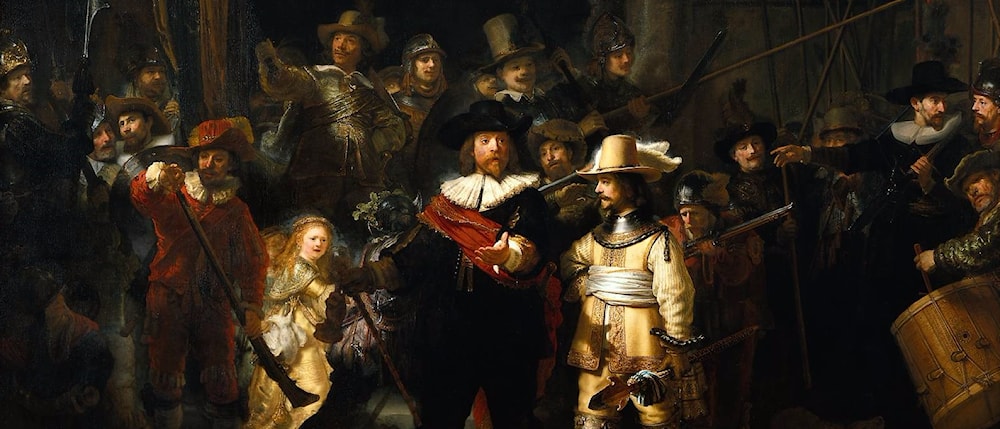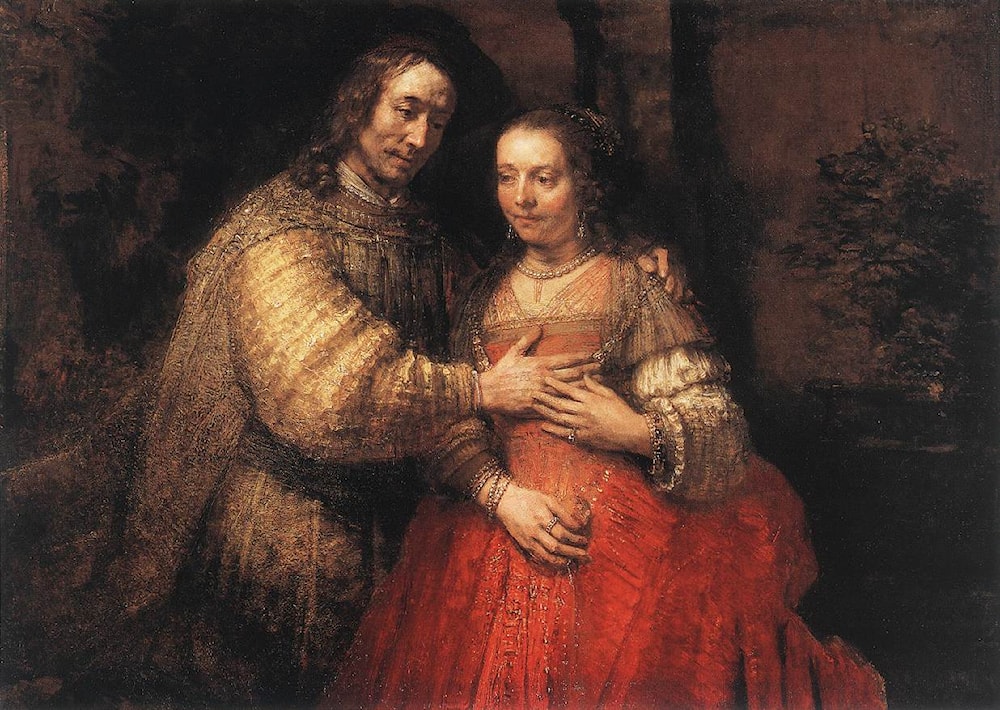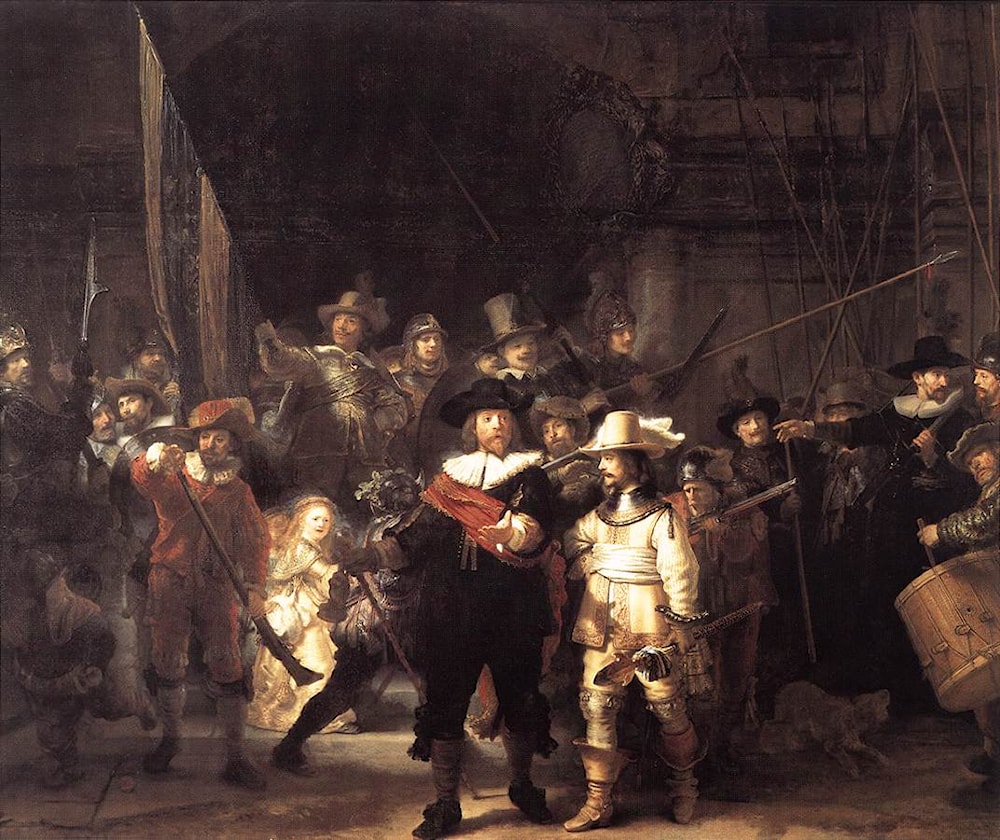The Technical Innovations of Rembrandt

Rembrandt Harmenszoon Van Rijn , whom many consider the greatest artist of all time, learned all that was then known about oil painting while still a very young man, surpassing his teachers very early in his career, and then proceeded to add his own discoveries to the technical knowledge of his time. To this day his best works remain unsurpassed, and serve as inspiration to the rest of us who paint. This being the case, any book on advanced techniques must address Rembrandt separately and at such length as the author's knowledge allows.
What technical information Rembrandt was taught may be discerned by studying the works of his instructors, Jacob Isaacszoon Van Swanenburch and Pieter Lastmann. Such study also immediately shows the genius of Rembrandt by the extent to which he so obviously surpassed them both, and in how early in his career he did so. Nonetheless, his training under them was an important factor in his artistic development, and should not be minimized. Both teachers seem to have possessed a working knowledge of the painting methods in use at that time, which Rembrandt learned from them. Various examples of his work show that he was not limited to any one technique, but employed them all, the choice depending on which approach best suited the subject in question, and for what purpose the painting was intended. His facility with all three of the aforementioned methods of painting soon led him to combine aspects of one with another, and to add innovations of his own.
Some of his paintings are on wood, executed in what appears to be essentially the Flemish Technique; some small studies on wood panels were done in a variation of the Direct Painting Technique, and some on canvas in both the Venetian and Direct techniques. The first layer of primer for the panels is glue-chalk gesso, which was sanded to smooth out the irregularities of the panel's surface, then a layer of white lead in linseed oil, with a small amount of Umber added, probably to speed drying, covered with a transparent brown imprimatura, which creates the golden glow characteristic of his work. Most of his canvases are primed with a double ground, the first layer of which is a red-orange ochre, perhaps to fill the texture of the canvas, then overlaid with a light, warm grey made from lootwit (lead white with chalk, ground in linseed oil), charcoal, Raw Umber, and various other earth colors
Rembrandt was an extremely versatile artist, and did not follow an unthinking repetition of the same procedure every time. He thought his way through each painting, from the genesis of the idea to the last brushstroke, never lapsing into a routine approach. From unfinished pictures, we know that, at least sometimes, he began in transparent browns, working in monochrome to establish the design of the picture, attending to the masses of dark and light, often using opaque white for the strongest lights in this stage, sometimes referred to as the imprimatura, or later, by the French academic painters, as a frottée, though the term, "frottée" generally referred to a thin brown scrub-in without white, the lights instead being simply indicated by leaving the light ground more or less exposed. This stage was apparently left to dry before proceeding further, though there may well have been exceptions. Over the dried brown underpainting, color was begun, with Rembrandt working from back to front rather than working over the whole picture at once. He exploited to the fullest the qualities of transparence and opacity, relying on the underglow of light coming through transparent color for many special effects, with opaque lights built up more heavily for the brightly lit areas, their colors sometimes modified by subtle glazes, semiglazes or scumbles, and the arrangement of transparent darks and opaque lights to play against one another for maximum visual impact and depth. Clues as to his choice of primer may be seen in areas where he has used a sharpened brush handle to scratch through wet paint in order to indicate bits of hair. This is evident in a very early self-portrait, now in The Hague, and in many other portraits. The primers and/or imprimaturas thus revealed show that he followed no one single procedure, but varied the choices, based on the effect he was after. The scratching with a sharpened brush handle into wet paint was one of his earlier innovations.
Early in his career he began building up the opaque passages in his lights more heavily, and texturing them to take on the physical convolutions of the lighted surfaces of his subjects, most notably the skin textures of male subjects, including himself. Exactly how he created this texture is unknown. It can be duplicated or approximated by building up a somewhat thick layer of opaque paint, then passing a soft brush over the surface while it is still wet. It seems Rembrandt began to superimpose glazes of red over these textured passages when dry, then wipe them off with a rag, leaving traces remaining in the low spots to create an even more convincing texture of rough flesh. A contemporary once said that a Rembrandt portrait could be picked up by the nose.
As he began to expand the effect of glazing over dried impasto to other textures as well, he devised a method employing two whites; one for impasto and one for smoother passages. The impasto white was faster-drying, probably made so by the addition of egg (traces of protein, presumed to be from egg, have been found in samples analyzed by conservation scientists), and/or ground glass, into the formulation. It was very lean, and consisted mostly of white lead with a minimum of binder. He began applying it more and more heavily as the first stage of a two (or more) stage operation which was finished with transparent glazes and wiping, to create fantastic special effects, the most extreme example of which is the man's glowing, golden sleeve in the painting referred to as The Jewish Bride, in the Rijksmuseum in Amsterdam. The brilliance of this effect cannot be gotten in any other way. He used the same technique on the bride's costume in the same painting, but here the underpainting contains vermilion, which is deepened with a glaze of a red lake, Carmine (Cochineal). The red carpet on the table in The Syndics of the Drapers' Guild (sometimes called The Dutch Masters), also in the Rijksmuseum, is done in much the same way, but with an earth red probably used in place of vermilion. The impasto underpaint appears to have been trowelled on with a knife or some sort of flat stick, then sculpted before it dried.
In Lieutenant Ruytenburch's uniform in The Night Watch, Rembrandt used this method, but with less heavy impasto, for the ornate brocade work. The wet underlayer was worked with sharpened brush handles and other tools while soft, and then allowed to dry before applying the darker glazes. By wiping the glazes off as soon as they were applied, Rembrandt was able to create a bas-relief effect of remarkable three-dimensionality as the glaze remained in the nooks and crannies. By glazing again, this time with transparent yellows and/or browns, instead of Ivory Black, he gave the textures a rich, golden glow.
Scientific analyses carried out by the National Gallery, London, show that Rembrandt added body to his glaze-like passages by mixing in a bit of chalk, which functions as an inert pigment essentially transparent when mixed with oil, and ground glass, which was probably used primarily to accelerate drying. The glass most likely would have contained lead and/or cobalt, both drying agents.
There has been a great deal of speculation as to what medium or mediums Rembrandt used, with most of the theories stating that one resin or another had to have been a major component. It now appears that these hypotheses may be in error. Recent studies of paint samples taken from a number of Rembrandt's paintings show no detectable resins. In most of the samples tested, only linseed oil was found, and/or sometimes walnut oil. In some cases some of the oil is reported to have been "heat-bodied," as in perhaps boiled or sun-thickened linseed oil. It is possible that these were added to the paints in which he wanted a long brushing quality, and in his glazes. The combination of polymerized oil and raw oil produces a resin-like substance without the undesirable properties of resins. Reinforced with chalk for body, and ground glass for body, faster drying and perhaps transparency, these appear to comprise Rembrandt's glazing media, as nearly as is discernible by the present level of scientific knowledge, which, it must be noted, is subject to change at any time, as new discoveries are made. For paints intended to be blended smoothly and opaquely, it is most likely that no medium was added, beyond the linseed or walnut oil in which the pigments were ground. The ground glass used as a dryer and bulking additive was probably a low grade of Smalt, less blue than the better grades, and low in tinting strength, so it could be mixed with any color without altering its appearance noticeably. Another blue pigment, Azurite, was also used as a drier.
The rest of Rembrandt's palette consisted of Bone Black or Ivory Black, less frequently Charcoal, a number of earth colors, as in Ochres, Siennas and Umbers, Cassel Earth, Lead-tin Yellow, occasionally Vermilion, a number of yellow and red lakes, high-grade Smalt (used as a blue), Azurite, Flake White (Schulpwit, i.e., lead carbonate without chalk), and Lootwit (lead carbonate with chalk). His brighter reds are more frequently earth reds, intensified with red lake pigments mixed into them, than Vermilion. He also often intensified his earth yellows with yellow lakes in the same way, for brighter yellows. As has already been mentioned, chalk was used as an inert pigment to add physical substance to transparent glazes and to transparentize other colors to varying degrees, and the lower grades of Smalt were used for these purposes and as siccative agents as well. In Rembrandt's method, drying was accomplished by adding fast-drying pigments to his mixtures. The principal pigments used for this purpose were Smalt, Azurite, Umbers and white lead.
Aside from his innovative special effects, Rembrandt's basic technique was much the same as that of his contemporaries. The lights were painted most opaquely, employing thick impasto highlights from a heavily-loaded, somewhat large hog-bristle brush, while the deepest darks were rendered more transparently, with dark opaque touches added in those areas while the larger, transparent dark masses were still wet. The lighter shadow areas were generally rendered with opaque paint, but applied more thinly than in the lights. Edges were adjusted for their proper degree of softness or sharpness while the colors on both sides of them were wet. The highly refined imagery of his younger days gradually gave way to a rougher, more painterly finish in his middle and later years, perhaps due to changes in his eyesight, but his basic methods of working remained essentially the same.
Rembrandt had at least one life-size jointed mannequin, on which he would pose the clothes of his sitters. The mannequin, unlike a living person, would remain motionless for as long as Rembrandt needed to paint the clothing, the folds remaining undisturbed for days, or weeks, if necessary. A live sitter would have to visit the bathroom, eat, sleep, move around, etc., after any of which the folds of the cloth would never be likely to resume their previous shape. The use of the mannequin may or may not have been Rembrandt's innovation, but it was, and is, a good idea regardless. We cannot expect to be able to rival the great genius of Rembrandt merely by following some of his procedures and using the same tools and materials he used. These are only a small part of his brilliance as an artist. At the core was his intelligence and artistic sense, his ability to constantly strive to improve upon what he had already done without losing sight of the original concept for the painting, to devise techniques, on the spot, which would create the effect he was after. We might hope to achieve the best results by adopting this same attitude towards our own work, rather than by attempting to reduce the methods of a great genius whose works we admire to a simple formula and then following it, unthinking. This is not meant to disparage technique, but to show it in its proper context. The more we know of technique, the more effects we have at our disposal, to serve our creativity and inspiration in the execution of our finest conceptions. If there is anything remotely approaching a formula for creating Great Art, it might be stated as the combination of knowledge and intuition in a single endeavor, plus a lot of work.





